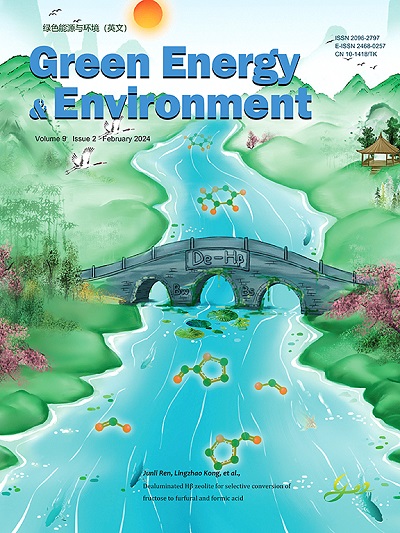Ti3C2 MXene nanosheets integrated cobalt-doped nickel hydroxide heterostructured composite: An efficient electrocatalyst for overall water-splitting
IF 10.7
1区 工程技术
Q1 CHEMISTRY, PHYSICAL
引用次数: 0
Abstract
Developing an efficient electrocatalyst for superior electrochemical water splitting (EWS) is crucial for achieving comprehensive hydrogen production. A heterostructured electrocatalyst, free of noble metals, TiC MXene nanosheet-integrated cobalt-doped nickel hydroxide (NHCoMX) composite was synthesized via a hydrothermal method. The abundant pores in the TiC MXene nanosheet (MX)–integrated microarchitecture increased the number of active sites and facilitated charge transfer, thus enhancing electrocatalysis. Specifically, the MX-enhanced charge transfer considerably transformed the microelectronic structure of cobalt-doped Ni(OH) (NHCo), which promoted its hydrogen evolution reaction (HER) and oxygen evolution reaction (OER). Hence, as an EWS catalyst, NHCoMX exhibited an exceptional electrocatalytic activity, demonstrating OER and HER overpotentials of 310 mV and 73 mV, respectively, with low Tafel slopes of 65 mV dec and 85 mV dec, respectively; it exhibited a current density of 10 mV cm in 1.0 mol L KOH, representing the closest efficiency to the noble state-of-the-art RuO and Pt/C catalyst. Furthermore, the developed electrocatalyst improved the activities of both HER and OER, leading to an overall EWS current density of 10 mA cm at 1.72 V in an alkaline electrolyte with two electrodes. This study describes an efficient heterostructured NHCoMX composite electrocatalyst. It is significantly comparable to the noble state-of-the-art electrocatalysts and can be extended to fabricate resourceful catalysts for large-scale EWS applications.Ti3C2 MXene 纳米片集成掺钴氢氧化镍异质结构复合材料:整体水分离的高效电催化剂
开发一种高效的电催化剂以实现卓越的电化学水分离(EWS),对于实现全面制氢至关重要。通过水热法合成了一种不含贵金属的异质结构电催化剂--TiC MXene 纳米片集成掺钴氢氧化镍(NHCoMX)复合材料。TiC MXene 纳米片(MX)集成微结构中丰富的孔隙增加了活性位点的数量,促进了电荷转移,从而增强了电催化能力。具体来说,MX 增强电荷转移大大改变了掺钴 Ni(OH)(NHCo)的微电子结构,促进了其氢进化反应(HER)和氧进化反应(OER)。因此,作为一种 EWS 催化剂,NHCoMX 表现出了非凡的电催化活性,其 OER 和 HER 过电位分别为 310 mV 和 73 mV,Tafel 斜率分别为 65 mV dec 和 85 mV dec;在 1.0 mol L KOH 中的电流密度为 10 mV cm,与最先进的贵金属 RuO 和 Pt/C 催化剂的效率最为接近。此外,所开发的电催化剂还提高了 HER 和 OER 的活性,在双电极碱性电解质中,1.72 V 时的整体 EWS 电流密度为 10 mA cm。本研究介绍了一种高效的异质结构 NHCoMX 复合电催化剂。该催化剂与最先进的贵金属电催化剂具有明显的可比性,并可扩展到为大规模 EWS 应用制造资源丰富的催化剂。
本文章由计算机程序翻译,如有差异,请以英文原文为准。
求助全文
约1分钟内获得全文
求助全文
来源期刊

Green Energy & Environment
Energy-Renewable Energy, Sustainability and the Environment
CiteScore
16.80
自引率
3.80%
发文量
332
审稿时长
12 days
期刊介绍:
Green Energy & Environment (GEE) is an internationally recognized journal that undergoes a rigorous peer-review process. It focuses on interdisciplinary research related to green energy and the environment, covering a wide range of topics including biofuel and bioenergy, energy storage and networks, catalysis for sustainable processes, and materials for energy and the environment. GEE has a broad scope and encourages the submission of original and innovative research in both fundamental and engineering fields. Additionally, GEE serves as a platform for discussions, summaries, reviews, and previews of the impact of green energy on the eco-environment.
 求助内容:
求助内容: 应助结果提醒方式:
应助结果提醒方式:


